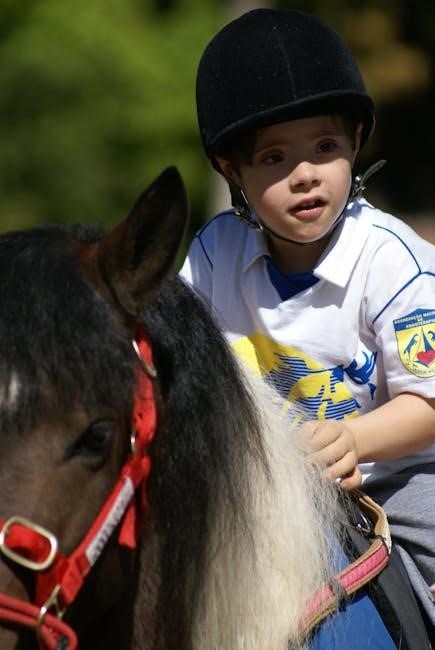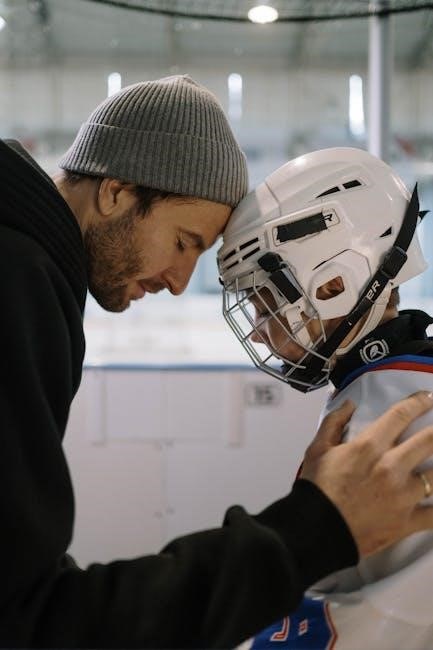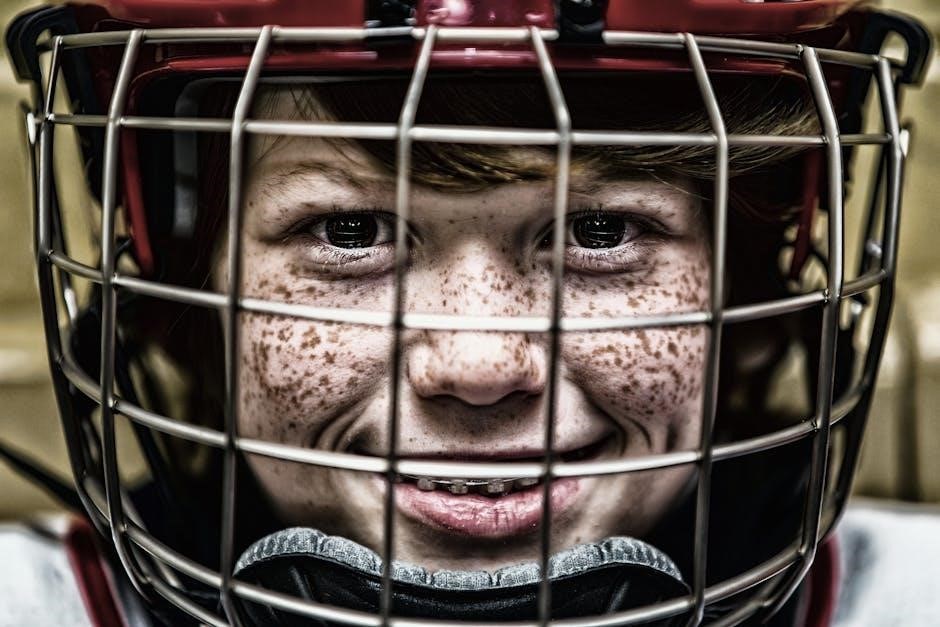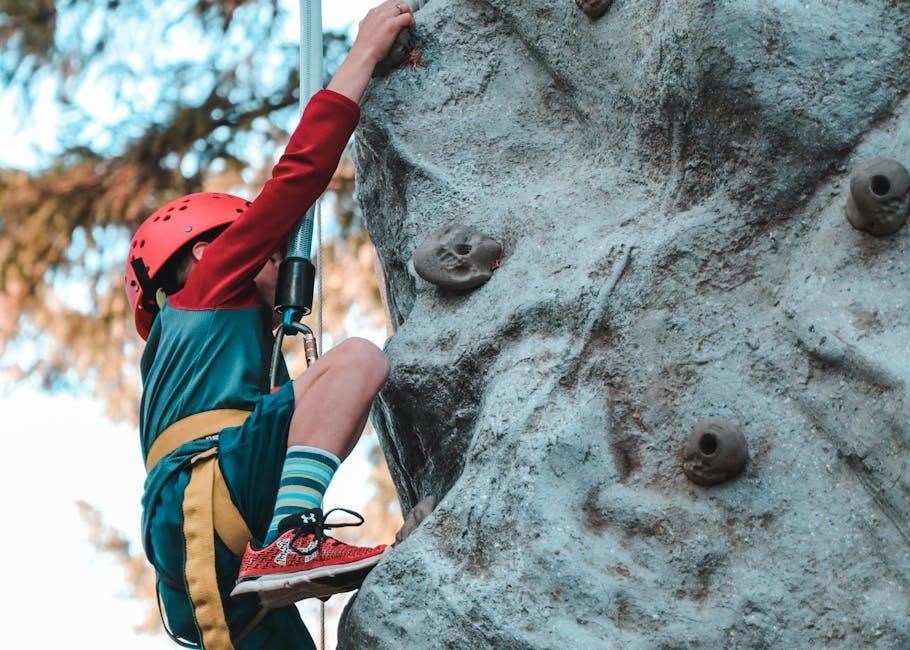A proper-fitting helmet is essential for a child’s safety and comfort. This guide helps determine the right size using head measurements and size charts, ensuring a secure fit.
1.1 Importance of Proper Helmet Fit for Kids
A proper-fitting helmet is critical for maximizing protection and safety. A well-fitted helmet ensures optimal coverage and reduces the risk of injury in case of a fall. If a helmet is too loose or too tight, it may not stay in place or provide adequate protection. Ensuring the right fit is essential to prevent accidents and guarantee comfort during activities like cycling or scooting. Using a size guide helps parents make informed decisions and ensures their child’s safety and confidence while wearing the helmet.
1.2 Purpose of a Size Guide
A size guide serves as a tool to help parents select the correct helmet size for their child. It provides a reference for measuring head circumference and matching it to appropriate helmet sizes. By using a size guide, parents can ensure the helmet fits properly, enhancing safety and comfort. It also helps avoid common mistakes like buying a helmet that’s too large or too small, ensuring the best possible protection and a secure fit for various activities such as biking or skating.

Understanding Head Measurement for Helmets
Accurate head measurement is crucial for selecting the right helmet size. Use a flexible tape measure to wrap around the head, positioning it above the eyebrows for an accurate fit.
2.1 Materials Needed for Measurement
To measure your child’s head accurately, you’ll need a flexible tape measure or a string. Place the tape around the head, about an inch above the eyebrows, ensuring it’s level and not too tight. This method provides a precise head circumference, essential for selecting the correct helmet size. Additional tools like a mirror or a second person can help ensure accuracy. The tape measure should be snug but comfortable, avoiding any tightness that could lead to an incorrect measurement.
2.2 Step-by-Step Measurement Process
Begin by gathering a flexible tape measure or string. Wrap it around the child’s head, positioning it about an inch above the eyebrows and ears. Ensure the tape is level and not tilted. Hold it snug but not too tight, as this could restrict movement. Record the measurement in centimeters or inches. For accuracy, repeat the process a few times and take the average. If using a string, mark the point where it overlaps and measure the length with a ruler. This ensures a precise fit for the helmet.
2.3 Common Mistakes to Avoid During Measurement
Ensure the tape measure is not too tight or too loose, as this can lead to inaccurate sizing. Avoid measuring over thick hairstyles or hats, as this can add extra circumference. Do not tilt the tape measure backward or forward, as it should remain level around the head. Additionally, prevent the child from slouching, as this can distort the measurement. Always measure with the child sitting or standing upright to ensure accuracy and reliability in determining the correct helmet size.

Children’s Helmet Size Charts
Charts provide head circumference measurements correlated with ages and sizes, helping determine the ideal helmet fit by matching measurements to specific size ranges for children.
3.1 Age and Head Circumference Correlation
Age and head circumference are closely linked in determining helmet size. Infants (0-12 months) typically have head sizes ranging from 33.9-45.8 cm, while toddlers (1-5 years) measure 47.2-51 cm. Older children (6-12 years) usually fall between 51-56 cm. These ranges help parents estimate the appropriate helmet size based on their child’s age, ensuring a proper fit for safety and comfort.
3.2 Size Charts by Popular Brands
Popular brands like Triple Eight, CORE, and Bell provide detailed size charts tailored to children’s head sizes. Triple Eight offers sizes from 46-52 cm, while CORE’s range includes XS/S (48-52 cm), S/M (51-56 cm), and L/XL (55-59 cm). Bell’s charts similarly categorize sizes for kids, ensuring accurate fit. These charts help parents match their child’s head circumference to the correct helmet size, optimizing safety and comfort. Always refer to the specific brand’s guide for precise measurements.
3.3 Converting Measurements to Helmet Sizes
Once you have your child’s head circumference, compare it to the size chart of the chosen brand. For example, a 50-56 cm measurement aligns with a medium size in many brands. Triple Eight helmets range from 46-52 cm (small) to 50-56 cm (medium), while CORE offers sizes like 48-52 cm (XS/S) and 51-56 cm (S/M). Always match the measurement to the brand’s specific chart to ensure the correct fit and optimal safety for your child.

How to Choose the Right Helmet Size
Measure your child’s head circumference using a flexible tape measure, then consult the brand’s size chart to find the corresponding helmet size for a proper fit.
4.1 Understanding the Size Chart
Understanding the size chart is crucial for selecting the right helmet. Measure your child’s head circumference using a flexible tape measure, then compare it to the chart. Most charts list sizes based on age and head circumference in centimeters or inches. For example, sizes range from 46-52cm for younger kids to 55-59cm for older children. Always refer to the specific brand’s chart, as sizes may vary slightly between manufacturers. This ensures a proper fit and optimal safety for your child.
4.2 Selecting by Age Group
Selecting a helmet by age group is a helpful starting point. For children, typical age ranges are 0-11 months, 1-5 years, and 6-12 years. Sizes correspond to head circumference, with 0-11 months fitting 33.9-45.8 cm, 1-5 years fitting 47.2-51 cm, and 6-12 years fitting larger sizes. Always check the specific brand’s chart, as sizes may vary slightly. While age provides a general guide, head shape and growth rates can differ, so precise measurements are essential for the best fit.
4.3 Considering Head Shape and Size
Head shape and size play a crucial role in selecting the right helmet. Children’s heads vary in shape, with some being rounder or more oval. Ensure the helmet fits snugly without pressure points. Use the fit system to adjust for a comfortable, secure fit. Proper fit ensures safety and comfort, regardless of head shape. Always refer to the manufacturer’s size chart and adjust the helmet’s fit system for optimal protection and comfort tailored to your child’s unique head shape and size.
How Helmets Should Fit
A helmet should fit snugly, sitting level on the head, with no rocking side to side. It must not slip backwards or tilt excessively while worn.
5.1 The “Level” Test
The “Level” Test ensures the helmet sits correctly on the head. Place the helmet so it rests evenly, with the front edge just above the eyebrows. Check that it doesn’t tilt backward or forward; When viewed from the side, the helmet should appear parallel to the ground. This proper positioning prevents excessive movement and ensures the helmet protects the forehead and back of the head effectively. A level fit guarantees optimal safety and comfort for your child.
5.2 The “V” Shape of the Straps
The straps should form a “V” shape under your child’s ears when properly adjusted. To achieve this, place the helmet on their head and fasten the chin strap. Adjust the straps so they sit comfortably just below the earlobes, creating a “V” shape. This ensures even distribution of pressure and prevents the helmet from shifting. If the straps are too loose or tight, the “V” shape will be distorted. Properly aligned straps enhance safety and comfort, keeping the helmet securely in place during activities.
5.3 The “One-Finger” Test for Chin Strap
The “One-Finger” Test ensures the chin strap is properly tightened. Place one finger between the strap and your child’s chin. The helmet should fit snugly, allowing only one finger to fit comfortably. If the space is too tight or too loose, adjust the strap. This test guarantees the helmet stays in place during movement without causing discomfort. Proper strap tension is crucial for safety, as a loose helmet can shift, while an overly tight one may cause discomfort or restrict movement.
Adjusting the Helmet for a Perfect Fit
Adjusting the helmet ensures optimal comfort and safety. Use the fit system to dial in the size, tighten straps for a snug fit, and add padding if needed.
6.1 Using the Fit System
The fit system allows for precise adjustments to ensure the helmet stays secure. Most helmets feature a dial at the back that can be turned to tighten or loosen the fit. To use it, place the helmet on your child’s head and adjust the dial until the helmet feels snug but not too tight. Ensure the helmet doesn’t rock side to side and the fit feels comfortable. This system helps achieve a customized fit without compromising safety or comfort.
6;2 Adjusting the Straps
Adjusting the straps ensures a secure and comfortable fit. Place the helmet on your child’s head and form a “V” shape with the straps around their ears. Tighten or loosen the straps until the helmet sits level and doesn’t rock forward or backward. Ensure the straps lie flat and aren’t too tight or loose. This adjustment prevents the helmet from shifting during activity and provides reliable protection. Always check the fit and make adjustments as needed for optimal safety and comfort.
6.3 Using Extra Padding
Extra padding can help refine the fit of a helmet that’s slightly too large. Place thin, removable pads inside the helmet to fill gaps and ensure a snug fit. These pads are often provided with the helmet or can be purchased separately. Position them strategically around the interior to address specific areas where the helmet feels loose. Always ensure the padding doesn’t interfere with the helmet’s safety features. Properly placed padding enhances comfort and maintains the helmet’s protective capabilities, ensuring optimal safety for your child.

Factors Influencing Helmet Size
Head growth, hair volume, and seasonal changes like wearing hats affect helmet fit. Regular adjustments and monitoring ensure optimal safety and comfort for children.
7.1 Growth and Development
Children’s heads grow rapidly, requiring frequent size checks. Ages 0-11 months: 33.9-45.8 cm; 1-5 years: 47.2-51 cm; 6-12 years: larger sizes. Regular measurements ensure proper fit and safety as they develop.
7.2 Hair Volume and Style
Hair volume and style can impact helmet fit. Thicker hair or certain styles may require a larger size. Measure with the child’s typical hairstyle to ensure accuracy. If they wear ponytails or braids, account for the added bulk. Some helmets offer adjustable padding to accommodate varying hair volumes, ensuring a secure and comfortable fit without compromising safety;
7.4 Seasonal Changes (Hats, Etc.)
Seasonal changes, such as wearing winter hats, can affect helmet fit. Thicker hats may require adjusting the helmet size or fit system. Measure your child’s head with their typical seasonal attire to ensure accuracy. As kids grow, their helmet size may change, especially if they wear hats during colder months. Regularly check the fit to maintain safety and comfort, ensuring the helmet remains secure and properly aligned throughout the year.
Common Mistakes to Avoid
Common mistakes include buying a helmet that’s too large, not adjusting the fit system, and ignoring strap importance, all of which compromise safety and comfort.
8.1 Buying a Helmet That’s Too Large
Buying a helmet that’s too large can lead to poor fit and reduced safety. A loose helmet may shift during impact, failing to protect critical areas like the temples and back of the head. It can also cause discomfort and distractions for the child. Always ensure accurate measurements and consult size charts to avoid this mistake. A well-fitting helmet stays securely in place, providing optimal protection and comfort. Regularly check fit as children grow to maintain safety standards.
8.2 Not Adjusting the Fit System
Not adjusting the fit system is a common mistake that compromises safety. A loose helmet can shift during impact, failing to protect properly. Ensure the fit system is tightened to create a snug, secure fit around the head. Proper adjustment prevents the helmet from rocking and ensures consistent protection. Always take the time to dial in the fit system for optimal safety and comfort, as a poorly adjusted helmet can lead to increased risk of injury. Proper fit is essential for effective protection.
8.3 Ignoring the Importance of Straps
Straps play a critical role in securing the helmet and ensuring proper fit. Neglecting to adjust them can lead to a loose helmet, which may shift during impact. Always ensure straps form a “V” shape under the ears and are snug under the chin. Loose or poorly adjusted straps compromise safety and protection. Regularly check for wear and tear on straps, as damaged ones can fail to hold the helmet in place. Proper strap adjustment is essential for optimal safety and comfort, preventing potential hazards during use.

Tips for Getting the Best Fit
Ensure your child tries the helmet on, check for comfort, and allow room for growth. Proper fit ensures safety and long-term usability.
9.1 Trying the Helmet On
Ensure your child tries the helmet on before purchasing. Use a flexible tape measure to determine head circumference, placing it 1 inch above the eyebrows. The helmet should sit level, not tilted, with the front edge just above the eyebrows. The chin strap should allow one finger between the strap and chin. Straps should form a “V” shape around the ears. The helmet should feel snug but not tight, allowing no more than one finger under the chin strap. Ensure it doesn’t rock side-to-side for a secure fit.
9.2 Checking for Comfort
Ensure the helmet feels comfortable for your child. The padding should be soft and evenly distributed to avoid pressure points. The chin strap should be snug but not tight, allowing one finger between the strap and chin. Check for breathability to prevent overheating. If the helmet causes discomfort or red marks, it may not be the right fit. Always prioritize your child’s comfort to encourage consistent use and ensure they can wear the helmet for extended periods without irritation.
9.3 Allowing Room for Growth
Allowing room for growth ensures the helmet remains effective as your child grows. A helmet should fit snugly but not too tight, with space for their head to develop. Using fit pads or adjustable systems can help customize the fit as your child’s head size increases. Regularly check the fit to ensure the helmet continues to meet safety standards. Proper fit today means safety and comfort as your child grows, making it essential to balance immediate needs with future development.

Different Types of Helmets
Children’s helmets vary by activity: bike helmets for cycling, scooter helmets for multi-sport use, and motorcycle helmets for high-speed protection. Each type offers unique features and safety measures.
10.1 Bike Helmets
Bike helmets are designed for cycling, offering lightweight protection with ventilation for comfort. They often feature visors and rear adjustment systems. To ensure proper sizing, measure your child’s head circumference and refer to the manufacturer’s size chart. A well-fitting bike helmet should sit level on the head, with straps forming a “V” shape around the ears. Always check for safety certifications like CPSC or ASTM to ensure reliability.
10.2 Scooter Helmets
Scooter helmets are designed for durability and low-speed impact protection, often featuring soft padding and adjustable straps. To ensure the proper fit, measure your child’s head circumference using a flexible tape measure, positioning it just above the eyebrows. The helmet should sit level, with straps forming a “V” shape around the ears. Allow room for growth and check for safety certifications like CPSC or ASTM. Always ensure a snug, comfortable fit for optimal protection during scooter rides.
10.3 Motorcycle Helmets
Kids’ motorcycle helmets are built for high-speed safety, offering advanced protection with features like padding and face shields. To ensure a proper fit, measure your child’s head circumference using a flexible tape measure, positioning it just above the eyebrows. The helmet should fit snugly without slipping, with straps securing it firmly. Look for safety certifications like DOT or Snell to ensure reliability. Proper fit is crucial for protection, so avoid oversized helmets and ensure comfort for extended rides.
Helmet Maintenance and Fit
Regular cleaning prevents damage, ensuring helmets remain safe. Check and replace worn-out parts for optimal protection. Store helmets in cool, dry places to maintain shape and fit.
11.1 Cleaning the Helmet
Regular cleaning is essential to maintain your child’s helmet safety and fit. Use a soft cloth and mild soap solution to wipe down the exterior and interior. Avoid harsh chemicals, as they may damage materials. Rinse thoroughly and air dry to prevent moisture buildup. Clean padding and remove liners for washing if possible. Regular cleaning prevents odor and ensures hygiene, keeping the helmet comfortable and safe for your child to wear.
11.2 Replacing Worn-out Helmets
Regularly inspect the helmet for signs of wear, such as dents, cracks, or worn padding. Helmets should be replaced immediately after a crash or impact, even if no visible damage is present. Additionally, helmets have a limited lifespan, typically 3-5 years, depending on usage. Replace the helmet if it no longer fits properly due to your child’s growth. Always ensure the new helmet meets current safety standards and fits securely for optimal protection.
11.4 Storing the Helmet Properly
Store the helmet in a cool, dry place away from direct sunlight and extreme temperatures. Avoid exposing it to chemicals or cleaning products. Never hang the helmet by its straps, as this can cause damage. Clean the helmet before storage to prevent dirt buildup. Use the original packaging if available, or a soft cloth to protect it. Proper storage ensures the helmet remains in good condition, maintaining its safety and fit for future use.
A well-fitting helmet ensures safety and comfort. Regularly check fit as your child grows, ensuring proper protection and comfort. Consult size charts for accuracy.
12.1 Final Tips for Parents
Always measure your child’s head to ensure accurate sizing. Use a flexible tape measure and consult the manufacturer’s size chart. Check the fit regularly as your child grows. Ensure the helmet sits level on their head, with straps forming a “V” shape. Avoid buying helmets that are too large for future use. Involve your child in the selection process to ensure comfort. Replace helmets after significant impacts or signs of wear. Prioritize certifications and reviews for safety assurance.
12.2 Ensuring Long-Term Safety
Regularly inspect the helmet for cracks or wear. Clean it with mild soap to maintain hygiene. Store it in a cool, dry place to prevent degradation. Replace the helmet after significant impacts or if it shows signs of aging. Ensure proper fit as your child grows. Check straps and padding for integrity. Always follow manufacturer guidelines for maintenance and replacement. A well-maintained helmet ensures long-term protection and safety for your child during their activities.

Additional Resources
Visit manufacturer websites like Triple Eight and Schwinn for detailed size charts. Check safety organizations such as CPSC for standards. Read customer reviews on platforms like Amazon and REI to find the best fit for your child.
13.1 Manufacturer Websites
Manufacturer websites like Triple Eight, Schwinn, and Bell offer detailed size charts and guides for children’s helmets. These resources provide precise measurements, step-by-step fitting instructions, and product-specific sizing information. For example, Triple Eight’s size guide includes head circumference ranges in both centimeters and inches. Visiting these sites ensures you find the perfect fit for your child by referencing the same data used by the manufacturers. This helps in making informed decisions when selecting a helmet.
13.2 Safety Organizations
Safety organizations like the Snell Memorial Foundation and the U.S. Consumer Product Safety Commission (CPSC) provide guidelines for helmet safety and sizing. These organizations ensure helmets meet safety standards and offer resources for proper fit. Websites like Twowheelingtots and others specialize in kids’ bike safety, offering detailed guides and tips. They often include size charts and advice on ensuring a secure fit, helping parents make informed decisions to protect their children effectively while cycling or engaging in other activities.
13.3 Customer Reviews
Customer reviews are invaluable for understanding real-world experiences with kids’ helmets. Parents share insights on fit, comfort, and durability, helping others make informed decisions. Reviews often highlight specific brands, like Triple Eight or Schwinn, and discuss how well helmets fit various head sizes. Many reviews emphasize the importance of proper sizing and provide tips for measuring accurately. Platforms like Amazon, specialty bike stores, and parenting blogs offer extensive feedback, guiding parents to the best options for their child’s safety and comfort.